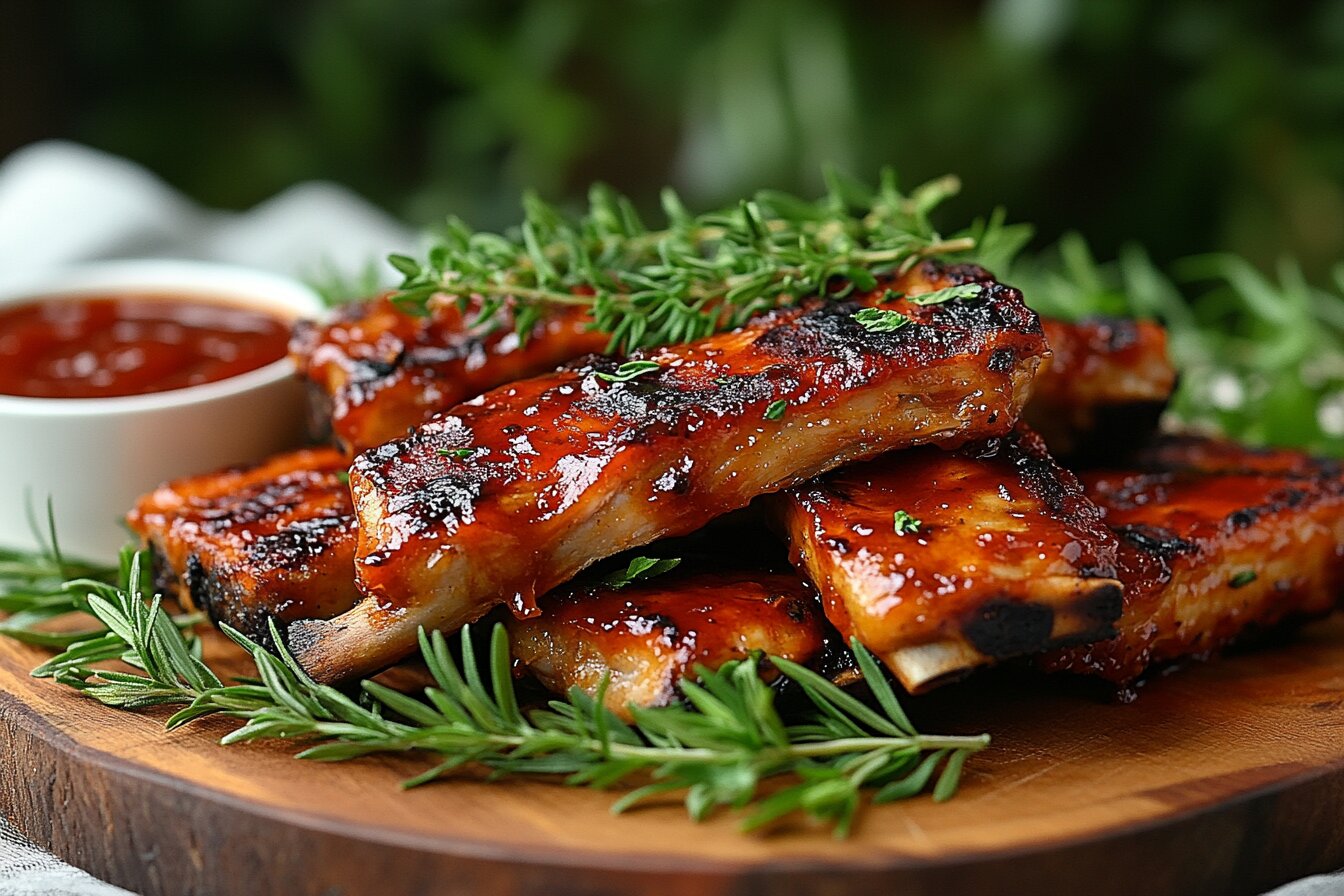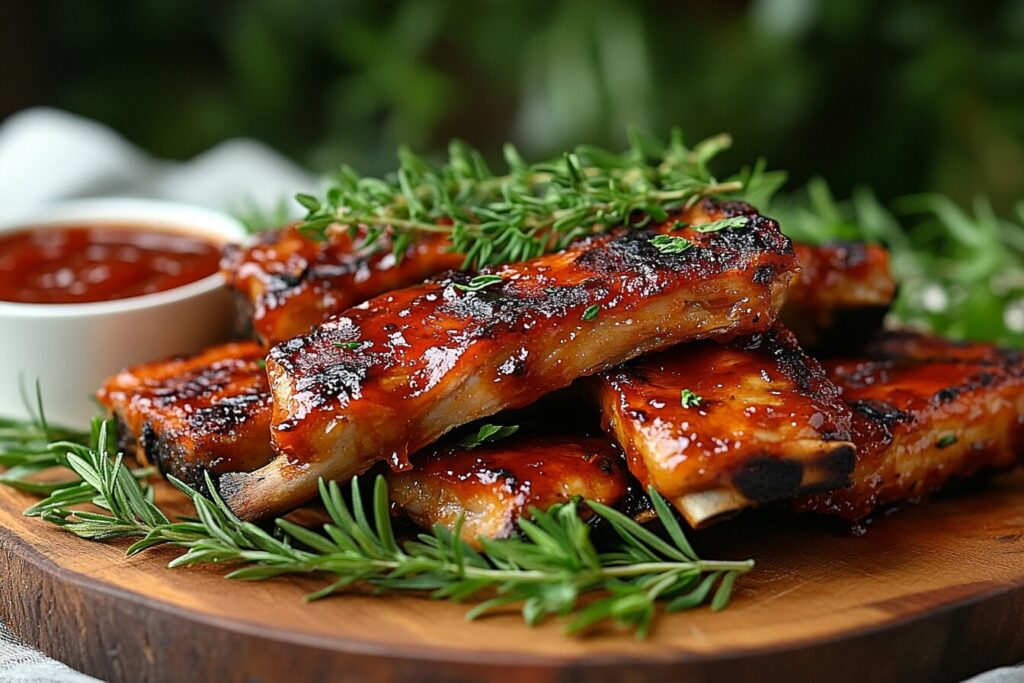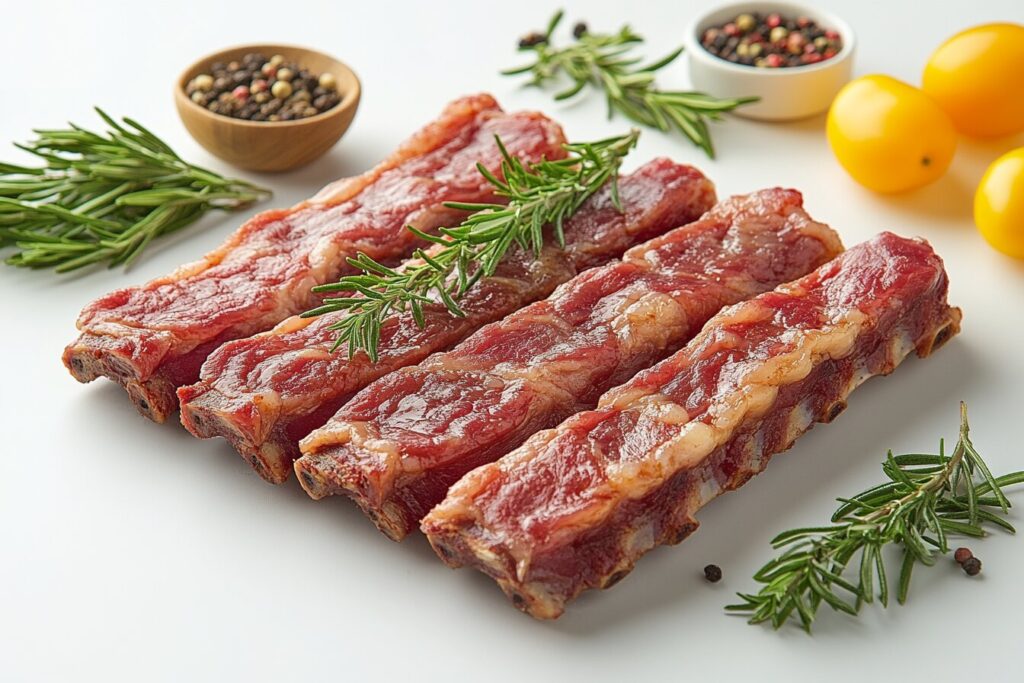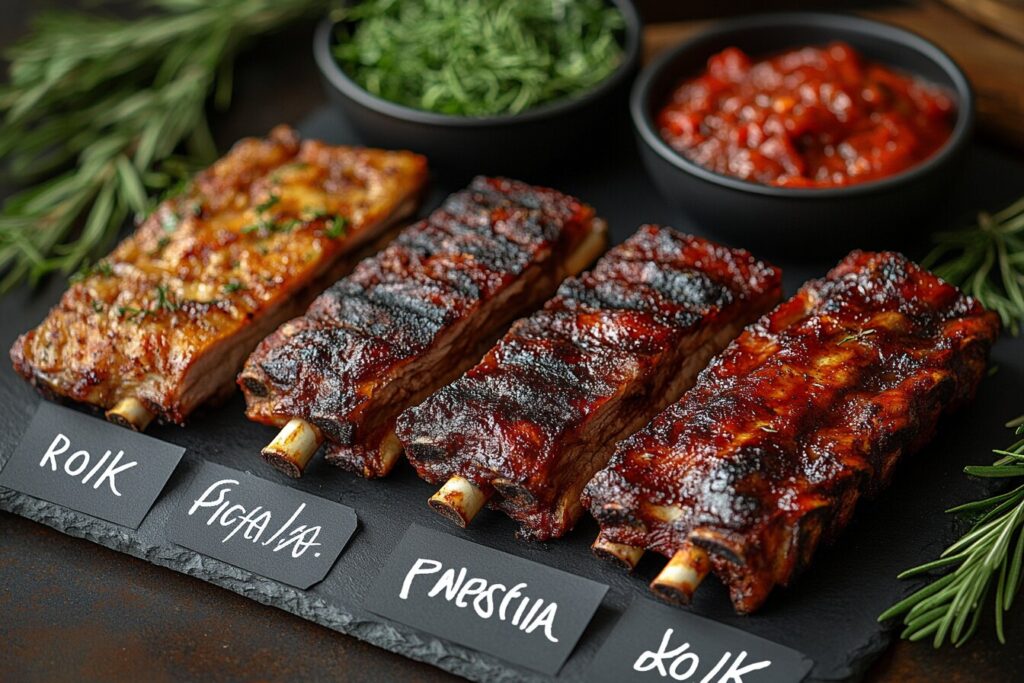When it comes to turkey, most of us think of the big, golden-brown bird on a holiday table. But what about turkey ribs? You might be scratching your head, wondering, “Wait…turkeys have ribs?” Don’t worry; we’re about to dive deep into this tasty and lesser-known turkey cut that’s capturing attention everywhere.
Introduction to Turkey Ribs
A Unique Cut: What Are Turkey Ribs?
Turkey ribs aren’t actually ribs in the way you might imagine pork or beef ribs. Instead, they’re a portion of the turkey located near the shoulder blade. This meaty, tender cut has a bone that gives it a rib-like appearance—hence the name.
Why are they special? They’re packed with flavor, versatile, and perfect for those who love the idea of “ribs” but are looking for a leaner alternative. Think of turkey ribs as the unsung hero of the turkey world, just waiting to steal the spotlight.
Why Are Turkey Ribs Gaining Popularity?
Turkey ribs are becoming popular for a few good reasons:
- Healthier Alternative: People are seeking leaner meat options, and turkey fits the bill.
- Flavor Explosion: Turkey ribs are like a flavor sponge, soaking up marinades and spices beautifully.
- Fun to Cook: Whether you’re grilling, smoking, or baking, turkey ribs are easy to work with and hard to mess up.
If you haven’t tried them yet, now’s your chance to hop on this delicious trend. You won’t regret it!
Anatomy of a Turkey: Where Do Turkey Ribs Come From?
Understanding the Cut: Breast vs. Ribs
Let’s clarify something: turkey ribs aren’t pulled from the same area as the turkey breast or drumsticks. They’re cut from the turkey’s shoulder, specifically around the scapula (shoulder blade). This area is meaty and flavorful, making it perfect for ribs.
How Turkey Ribs Are Separated During Butchering
During processing, butchers carefully remove the turkey ribs from the shoulder area. The process involves carving out the meat along the shoulder blade, ensuring there’s enough meat around the bone to make it rib-like. This precise cut is what gives turkey ribs their signature look and texture.
Flavor and Texture of Turkey Ribs
Comparison to Chicken and Pork Ribs
Ever wonder how turkey ribs stack up against their more famous counterparts? Let’s break it down:
- Turkey vs. Chicken Ribs: Turkey ribs are meatier and have a slightly richer flavor compared to chicken.
- Turkey vs. Pork Ribs: Pork ribs are fattier, making them more tender, but turkey ribs have a cleaner taste and are a healthier option.
Think of turkey ribs as the Goldilocks of ribs—not too fatty, not too lean, but just right.
Are Turkey Ribs Suitable for Barbecuing?
Absolutely! Turkey ribs are perfect for barbecuing. They hold up well on the grill, soak in smoky flavors, and develop a beautiful char. Add your favorite barbecue sauce, and you’ve got a winner!
Nutritional Benefits of Turkey Ribs
Protein Content
Turkey ribs are a fantastic source of protein. Here’s a quick breakdown:
| Nutritional Facts | Per 100g |
|---|---|
| Calories | 140-160 |
| Protein | 24-26g |
| Fat | 4-6g |
| Carbohydrates | 0g |
| Iron | 1.2mg |
As you can see, turkey ribs are a lean, protein-packed option, making them great for athletes, dieters, or anyone looking to eat healthier.
Low-Fat Alternative to Traditional Ribs
Turkey ribs contain significantly less fat than pork or beef ribs, but they don’t skimp on flavor. If you’re watching your waistline, they’re an excellent choice without feeling like you’re sacrificing taste.
“Turkey ribs are proof that healthy eating doesn’t have to be boring.”
How to Cook Turkey Ribs
Grilling Turkey Ribs
Grilling is the classic way to cook turkey ribs. Just like with other ribs, marinating is key. Throw them on the grill over medium heat, baste with sauce, and cook until they’re beautifully caramelized.
Baking Turkey Ribs
For a foolproof method, bake your turkey ribs. Preheat your oven to 375°F (190°C), season the ribs, and cover them with foil. Bake for 30-40 minutes, remove the foil, and bake another 10-15 minutes for a golden-brown finish.
Smoking Turkey Ribs
Smoking turkey ribs takes them to the next level. The slow cooking process infuses the ribs with a smoky flavor that’s downright irresistible. Hickory or mesquite wood chips work best.
“Want ribs that taste like they came from a fancy barbecue joint? Smoke ‘em!”
Common Problems When Cooking Turkey Ribs and Solutions
Why Are My Turkey Ribs Dry?
Dry turkey ribs? That’s no fun. The most common cause is overcooking. Turkey ribs are lean, so they don’t need as much cooking time as pork or beef ribs.
Solution: Use a meat thermometer and cook until they reach an internal temperature of 165°F (74°C).
How to Prevent Turkey Ribs from Sticking to the Grill
Nobody likes scraping meat off the grill. Prevent sticking by brushing the grill with oil before placing the ribs.
The Best Marinades to Enhance Flavor
Turkey ribs love marinades. A simple mix of olive oil, garlic, lemon juice, and your favorite herbs works wonders. Let the ribs soak for at least 2 hours—or overnight if you can wait.
More Recipes Featuring Turkey Ribs
The beauty of turkey ribs lies in their versatility—they’re a blank canvas for your culinary creativity. Let’s explore more delicious recipes to help you enjoy this underrated cut.
Smoky Chipotle Turkey Ribs
If you’re a fan of bold, smoky flavors, this recipe will hit the spot. The chipotle marinade gives these turkey ribs a mouthwatering kick.
Ingredients:
| Ingredient | Quantity |
|---|---|
| Turkey ribs | 2 lbs |
| Chipotle peppers in adobo | 2 tbsp |
| Lime juice | 2 tbsp |
| Garlic powder | 1 tsp |
| Olive oil | 2 tbsp |
Instructions:
- Blend chipotle peppers, lime juice, garlic powder, and olive oil into a smooth marinade.
- Coat the turkey ribs with the marinade and let them rest for 4-6 hours.
- Grill over medium heat for 20-25 minutes, flipping occasionally, until they’re smoky and tender.
“Pro tip: Serve with a side of fresh coleslaw to balance the heat!”
Herb-Crusted Turkey Ribs
This recipe combines fresh herbs and breadcrumbs for a crispy, flavorful crust.
Ingredients:
| Ingredient | Quantity |
|---|---|
| Turkey ribs | 2 lbs |
| Fresh parsley (chopped) | 3 tbsp |
| Garlic (minced) | 2 cloves |
| Breadcrumbs | 1 cup |
| Olive oil | 2 tbsp |
Instructions:
- Preheat your oven to 400°F (200°C).
- Mix parsley, garlic, breadcrumbs, and olive oil in a bowl.
- Coat the turkey ribs with the herb mixture and bake for 25-30 minutes, or until golden brown.
“Craving a fancier dinner? Pair these ribs with roasted potatoes and steamed green beans.”
Cajun-Style Turkey Ribs
Bring some Southern flair to your table with this spicy, flavorful recipe.
Ingredients:
| Ingredient | Quantity |
|---|---|
| Turkey ribs | 2 lbs |
| Cajun seasoning | 2 tbsp |
| Brown sugar | 1 tbsp |
| Paprika | 1 tsp |
| Lemon juice | 2 tbsp |
Instructions:
- Rub turkey ribs with Cajun seasoning, brown sugar, and paprika.
- Squeeze lemon juice over the ribs and let them marinate for 2 hours.
- Grill or bake at 375°F (190°C) for 30 minutes, or until fully cooked.
“These Cajun ribs are perfect for a backyard cookout or a cozy dinner at home.”
Turkey Ribs for Meal Prep
Turkey ribs aren’t just for special occasions—they’re a great choice for meal prep, too. Cook a big batch on Sunday and use them in different meals throughout the week. Here are a few ideas:
- Rib Tacos: Shred the meat and stuff it into tortillas with salsa, cheese, and lettuce.
- Rib Salad: Top a fresh garden salad with warm turkey rib slices for a protein boost.
- Rib Sandwich: Layer the meat on a crusty bun with barbecue sauce and coleslaw.
Turkey Ribs vs. Other Turkey Cuts
Turkey ribs aren’t the only part of the bird worth exploring, but they stand out for a few reasons.
Turkey Ribs vs. Turkey Wings
- Meatiness: Turkey ribs are meatier than wings, making them more filling.
- Flavor: Both cuts are flavorful, but ribs have a slightly richer taste due to their location on the bird.
- Cooking Style: Wings are best for frying or baking, while ribs shine on the grill or smoker.
“Think of wings as the party snack and ribs as the main event!”
Turkey Ribs vs. Turkey Drumsticks
- Texture: Drumsticks can be tougher due to their higher collagen content, whereas ribs are naturally tender.
- Cooking Time: Ribs cook faster, making them a more convenient choice for busy nights.
- Versatility: Ribs can easily adapt to a variety of recipes, while drumsticks are more traditional.
Turkey Ribs vs. Pork Ribs
- Health Factor: Turkey ribs are leaner, with less fat and calories.
- Flavor Profile: Pork ribs have a richer, fattier taste, but turkey ribs soak up marinades just as well.
- Cost: Turkey ribs are often more affordable, making them a budget-friendly alternative.
“If you’re looking for a guilt-free rib experience, turkey ribs are the way to go.”
Storing and Reheating Turkey Ribs
To make the most of your turkey ribs, proper storage and reheating techniques are essential.
How to Properly Store Cooked Turkey Ribs
Once cooked, turkey ribs should be cooled and stored promptly to maintain their quality.
- Refrigeration: Store in an airtight container and refrigerate within 2 hours of cooking.
- Shelf Life: 3-4 days in the fridge.
- Freezing: Wrap tightly in plastic wrap or aluminum foil and place in a freezer-safe bag.
- Shelf Life: Up to 3 months in the freezer.
Best Methods for Reheating Without Losing Flavor
Reheating turkey ribs without drying them out is a challenge, but these tips will help:
- Oven: Preheat to 350°F (175°C). Place the ribs in a baking dish with a splash of broth or water, cover with foil, and bake for 10-15 minutes.
- Grill: Reheat over low heat, brushing with barbecue sauce to keep them moist.
- Stovetop: Heat in a covered skillet with a bit of water or sauce.
“Avoid the microwave—it can zap the moisture right out of your ribs!”
Conclusion
Turkey ribs are a hidden gem in the world of poultry, offering a unique combination of flavor, nutrition, and versatility. Whether you’re grilling them for a summer barbecue, baking them for a cozy family dinner, or trying out new recipes, turkey ribs are sure to impress.
So why not give them a try? After all, the best meals often come from stepping outside your comfort zone and exploring something new. Who knows? Turkey ribs might just become your next favorite dish.




